Top Applications for Membrane Switches in Consumer Electronics
Top Applications for Membrane Switches in Consumer Electronics
Blog Article
Recognizing the Significance of Membrane Switches in Customer Interfaces
Membrane switches are integral elements in the design of reliable individual interfaces, facilitating not just functionality yet also boosting aesthetic allure and individual communication. Their distinct attributes, such as resistance to adjustable layouts and environmental variables, make them ideal for a diverse variety of applications across numerous industries. As we check out the future patterns and different benefits related to Membrane innovation, it comes to be clear that these buttons are greater than just components; they represent a merging of technology and functionality. The implications of this modern technology on user experience deserve checking out even more.
What Are Membrane Buttons?

The spacer layer, which includes adhesive homes, permits the separation of the circuit layer from the overlay, making certain that the button stays in a non-activated state until pushed. When pressure is related to the overlay, it presses the spacer layer, connecting the gap and finishing the circuit in the underlying layer. This style not only lowers the physical area required for typical mechanical buttons but additionally improves the sturdiness of the device, as Membrane switches are usually resistant to dirt, wetness, and other ecological elements.
Generally discovered in applications varying from consumer electronics to clinical devices, Membrane buttons are important to modern innovation, providing a user-friendly and efficient interface that aligns with modern design demands.
Advantages of Membrane Buttons
While numerous button technologies exist, Membrane Switches deal unique benefits that make them particularly desirable in numerous applications. One of the main advantages of Membrane switches is their small layout, which enables space-saving applications in tools where realty is restricted. Their slim profile not only improves visual appeal however likewise facilitates lightweight building.
An additional significant advantage is their resistance to environmental aspects. Membrane switches are generally secured versus dampness, dirt, and contaminants, making them optimal for usage in requiring settings, such as medical devices and industrial devices. This toughness expands the lifespan of the switch, decreasing maintenance expenses and improving integrity.
In addition, Membrane buttons can be tailored to fulfill specific design requirements, incorporating distinct graphics and colors that enhance user interaction. Their tactile feedback options can also be customized to provide a satisfying user experience. In addition, Membrane buttons are economical, especially in high-volume applications, as they can be created effectively.
Applications in Different Industries

In the customer electronic devices sector, Membrane switches are widespread in gadgets such as microwaves, washing makers, and remote controls. Their responsive comments and visual choices boost individual experience while providing a smooth, modern appearance. Additionally, vehicle manufacturers use Membrane switches in control panel controls and infotainment systems, where room is limited, and individual engagement is important.
Moreover, the commercial field leverages Membrane buttons in control panels for equipment and devices, permitting intuitive operation in usually severe settings. Their resistance to chemicals and moisture makes sure long life and reliability in these applications. Generally, the adaptability of Membrane Switches adds considerably to their extensive usage, making them essential in different technical domain names.
Design Considerations for Membrane Buttons

When creating Membrane switches, numerous essential factors to consider need to be taken into consideration to guarantee find more information ideal functionality and customer experience. The choice of products is important; choosing durable, high-quality substratums can improve the button's longevity and resistance to environmental elements such as dampness and temperature level fluctuations.
Secondly, the layout of the graphic overlay need to focus on clearness and convenience of usage. Icons and text must be clear, and the format ought to assist in Go Here intuitive interaction (membrane switches). Furthermore, responsive responses is important; incorporating a responsive dome or other mechanisms can boost the individual experience by offering physical confirmation of activation
An additional essential factor is the button's electrical efficiency. Developers must make certain that the conductive traces are appropriately developed to minimize resistance and prevent signal interference. This entails evaluating the required actuation pressure and ensuring compatibility with the digital components they will certainly interface with.

Future Patterns in Membrane Innovation
As modern technology remains to breakthrough, Membrane switches are poised to advance considerably, driven by technologies in materials and producing strategies. One emerging pattern is the unification of advanced products, such as conductive inks and flexible substrates, which enhance sturdiness and lower the overall weight of Membrane buttons. These products not just improve the tactile action yet also enable the layout of buttons that can withstand harsher environmental conditions.
Moreover, the assimilation of touch-sensitive technologies is transforming conventional Membrane Switches right into even more interactive interface. Capacitive touch sensing units embedded within Membrane switch panels can offer a much more instinctive and receptive customer experience, straightening with the expanding need for sleek, modern designs in consumer electronics.
Additionally, developments in printing techniques, such as digital and 3D printing, enable rapid prototyping and customization of Membrane switches. This flexibility allows manufacturers to react extra promptly to market needs and customer choices.
Finally, sustainability is ending up being a considerable focus, with manufacturers exploring eco-friendly materials and procedures. As these fads unfold, the future of Membrane technology assures boosted capability, aesthetic appeal, and environmental obligation, solidifying their duty in innovative interface throughout different industries.
Conclusion
In final thought, Membrane Switches represent an essential element in the design of customer interfaces, incorporating performance with aesthetic versatility. As advancements in innovation proceed, the evolution of Membrane buttons is expected to additional improve user interfaces, driving advancement and boosting usability in a significantly complicated technological landscape.
Membrane buttons are essential components in the layout of effective individual interfaces, promoting not just functionality however additionally boosting aesthetic appeal and individual communication.Membrane Switches serve as a vital element in various customer interfaces, assisting in a seamless interaction between individuals and digital tools.While numerous switch technologies exist, Membrane Switches deal unique benefits that make them especially desirable in different applications.Moreover, Membrane buttons can be customized to meet specific design requirements, incorporating distinct graphics and colors that enhance user interaction.In final thought, click here for info Membrane Switches stand for a vital element in the layout of user interfaces, combining capability with visual adaptability.
Report this page